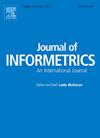Top research performance in Poland over three decades: A multidimensional micro-data approach
IF 3.5
2区 管理学
Q2 COMPUTER SCIENCE, INTERDISCIPLINARY APPLICATIONS
引用次数: 0
Abstract
In this research, the contributions of a highly productive minority of scientists to the national Polish research output over the past three decades (1992–2021) is explored. A large population of all internationally visible Polish scientists (N = 152,043) with their 587,558 articles is studied. In almost all previous research, the approaches to high research productivity are missing the time component. Cross-sectional studies were not complemented by longitudinal studies: Scientists comprising the classes of top performers have not been tracked over time. Three classes of top performers (the upper 1 %, 5 %, and 10 %) are examined, and a surprising temporal stability of productivity patterns is found. The 1/10 and 10/50 rules consistently apply across the three decades: The upper 1 % of scientists, on average, account for 10 % of the national output, and the upper 10 % account for almost 50 % of total output, with significant disciplinary variations. The Relative Presence Index (RPI) we constructed shows that men are overrepresented and women underrepresented in all top performers classes. Top performers are studied longitudinally through their detailed publishing histories, with micro-data coming from the raw Scopus dataset. Econometric models identify the three most important predictors that change the odds ratio estimates of membership in the top performance classes: gender, academic age, and research collaboration. The downward trend in fixed effects over successive six-year periods indicates increasing competition in Polish academia.
三十年来波兰的顶尖研究业绩:多维微观数据方法
本研究探讨了过去三十年(1992-2021 年)中少数高产科学家对波兰国家研究成果的贡献。研究对象包括波兰所有国际知名科学家(N=152,043)及其 587,558 篇文章。在以往几乎所有的研究中,提高科研生产率的方法都缺少时间部分。横向研究没有得到纵向研究的补充:没有长期跟踪研究绩优类科学家。我们对三个等级的顶尖科学家(1%、5% 和 10%)进行了研究,发现他们的生产率模式具有惊人的时间稳定性。1/10 和 10/50 规则始终适用于这三个十年:排名前 1%的科学家平均占全国产出的 10%,排名前 10%的科学家几乎占总产出的 50%,但学科之间存在显著差异。我们构建的 "相对存在指数"(RPI)显示,在所有最高级别的科学家中,男性比例偏高,女性比例偏低。我们通过详细的出版历史对绩优者进行了纵向研究,微观数据来自原始的 Scopus 数据集。计量经济学模型确定了三个最重要的预测因素:性别、学术年龄和研究合作。固定效应在连续六年期间的下降趋势表明波兰学术界的竞争日益激烈。
本文章由计算机程序翻译,如有差异,请以英文原文为准。
求助全文
约1分钟内获得全文
求助全文
来源期刊

Journal of Informetrics
Social Sciences-Library and Information Sciences
CiteScore
6.40
自引率
16.20%
发文量
95
期刊介绍:
Journal of Informetrics (JOI) publishes rigorous high-quality research on quantitative aspects of information science. The main focus of the journal is on topics in bibliometrics, scientometrics, webometrics, patentometrics, altmetrics and research evaluation. Contributions studying informetric problems using methods from other quantitative fields, such as mathematics, statistics, computer science, economics and econometrics, and network science, are especially encouraged. JOI publishes both theoretical and empirical work. In general, case studies, for instance a bibliometric analysis focusing on a specific research field or a specific country, are not considered suitable for publication in JOI, unless they contain innovative methodological elements.
 求助内容:
求助内容: 应助结果提醒方式:
应助结果提醒方式:


